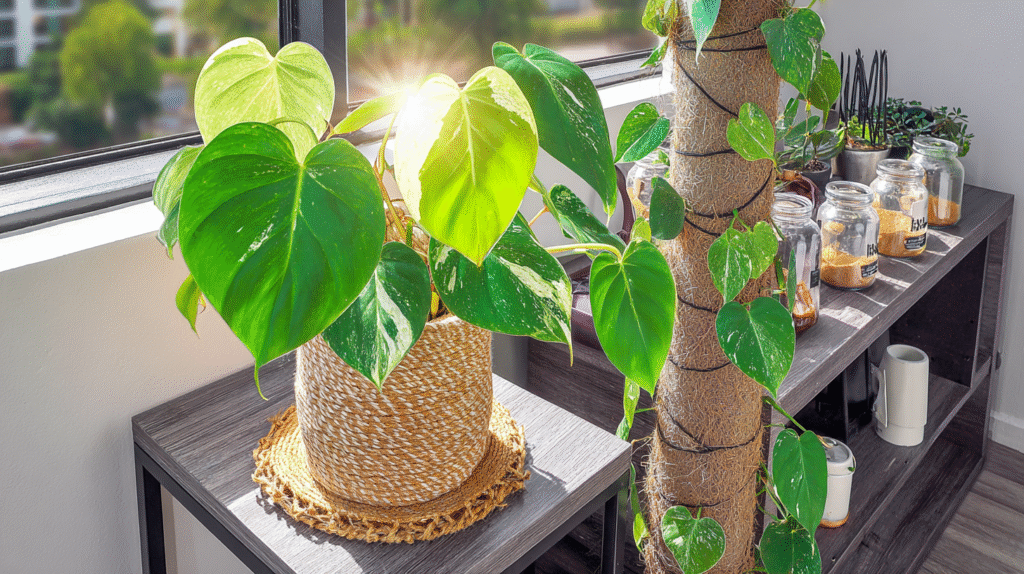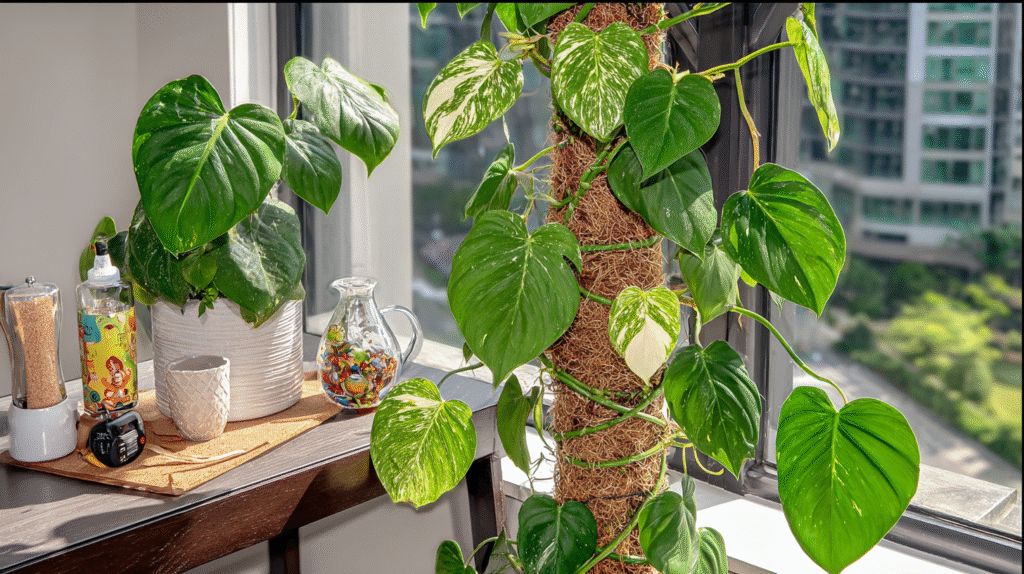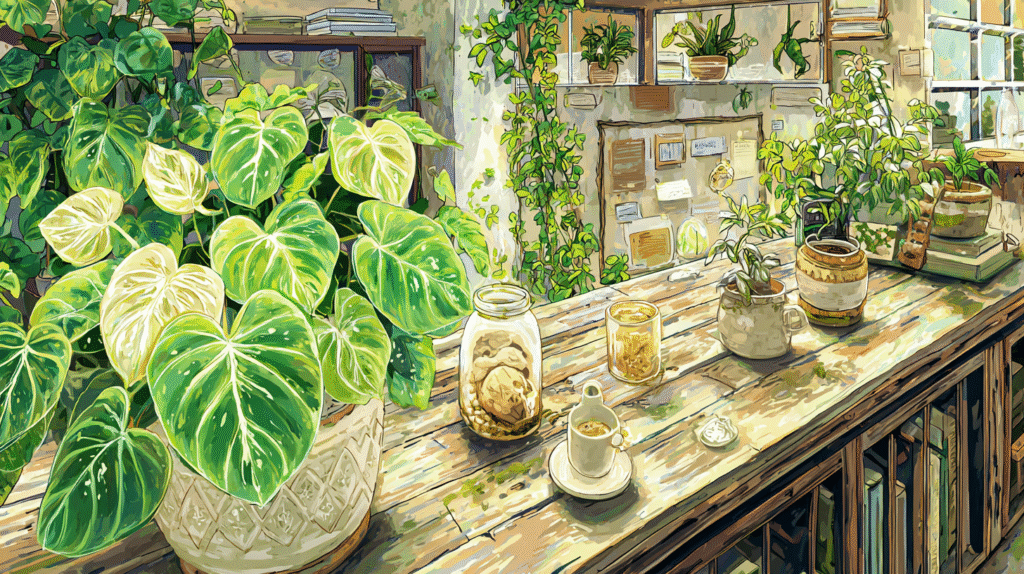Everyone said philodendrons were foolproof. “Perfect for beginners!” they said. “Thrives on neglect!” they promised. So why was my first philodendron a leggy, yellow-leafed mess that looked like it was auditioning for a plant horror movie?
Three years and seventeen philodendrons later (yes, I have a problem), I finally understand why these plants have such a bulletproof reputation – and why so many of us still manage to make them look terrible. Turns out “easy care” doesn’t mean “no care,” and philodendrons are really good at surviving while looking absolutely miserable.
Now my apartment looks like a philodendron jungle, with varieties trailing from shelves, climbing moss poles, and taking over entire corners. Here’s everything I learned the hard way about making these supposedly simple plants actually thrive instead of just survive.

My Philodendron Wake-Up Call
My first heartleaf philodendron came from a grocery store. Within a month, it had:
- Leaves yellowing and dropping
- Stems stretching toward the window like desperate tentacles
- New leaves coming in smaller and smaller
- An overall vibe of deep plant depression
I thought I was doing everything right – weekly watering, no direct sun, the occasional misting. Turns out I was doing everything just wrong enough to keep it alive but miserable. Like feeding someone nothing but crackers – they won’t die, but they won’t thrive either.
The Philodendron Truth Nobody Mentions
Here’s what changed everything: philodendrons don’t want to just survive in your home. They want to take it over. In their natural habitat, these things are monsters, climbing trees and spreading everywhere. That sad little plant in a 4-inch pot? It’s dreaming of world domination.
Once I started treating them like the vigorous growers they want to be instead of delicate houseplants, everything changed.
Light: The Difference Between Surviving and Thriving
Every care guide says “medium indirect light,” which is about as helpful as saying “cook until done.”
What actually works:
- Heartleaf types: 3-5 feet from any window
- Variegated types: Brighter light to maintain patterns
- All types: More light = faster growth and bigger leaves
My light experiment results:
- North window: Alive but leggy and sad
- East window: Happy and growing steadily
- South window with sheers: Absolutely exploding with growth
- Dark corner: Don’t even try it
My Brasil philodendron in the bathroom with just a frosted window? Surviving. The one 4 feet from my south window? It’s tripled in size and the variegation is stunning.
Watering: Where I Was Completely Wrong
I was that person watering on a schedule. Every Sunday, like clockwork. Half my plants had root rot, the other half were chronically thirsty.
What actually works:
- Check the top 2 inches of soil
- If dry, water thoroughly
- If moist, walk away
- In summer, that’s every 5-7 days
- In winter, maybe every 2 weeks
The game-changer: I started lifting my pots to check weight. Light pot = thirsty plant. You learn the difference fast.
Water quality matters: My tap water is super hard. Switched to filtered water for my variegated types after their leaves developed brown edges. Instant improvement.
The Soil Situation That Fixed Everything
Used regular potting soil for two years. Always either too wet or bone dry, no in-between. Finally made my own mix:
My philodendron mix:
- 40% quality potting soil
- 30% perlite
- 20% orchid bark
- 10% worm castings
This drains fast but holds some moisture. My root rot problems disappeared overnight.
For my climbing types: Added extra orchid bark for even more drainage. They love it.
Varieties: My Successes and Failures
Heartleaf (The Gateway Drug): Started with one, now have four. Incredibly forgiving, grows anywhere, propagates if you look at it funny.
Brasil (The Show-Off): Yellow variegation needs more light than you think. Mine in low light reverted to solid green. Moved to brighter spot = variegation returned.
Micans (The Velvet Diva): Velvety leaves are gorgeous but show every water spot. Bottom-water only. Needs humidity or gets crispy.
Pink Princess (The Expensive Mistake): Paid $150. Gave it perfect care. Still died. Some philodendrons choose violence. Now I stick to the easier ones.
Birkin (The Surprise Success): Expected drama, got an easy grower. Bright light keeps the white pinstripes. Lower light = reverting to green.

Propagation: Infinite Free Plants
This is where philodendrons really shine. I’ve created an army from my original plants.
Water propagation:
- Cut below a node (the bumpy bit)
- Remove lower leaves
- Stick in water
- Roots in 1-2 weeks
- Plant when roots are 2 inches
My success rate: 95% in water, 70% in soil
Pro tip: I keep a propagation station going constantly. Always have baby plants for gifts or trades.
The Support Question
Letting them trail is fine, but supporting climbers changed the game:
Moss poles:
- Bigger leaves
- Tighter growth
- More “mature” form
- Pain to keep moist
My lazy solution: Bamboo stakes for structure, don’t worry about aerial roots attaching. Works fine, less maintenance.
Pest Drama and Solutions
Thought “easy care” meant “pest-free.” Wrong.
Spider mites: My nemesis. Check undersides of leaves regularly. Shower monthly as prevention.
Thrips: Destroyed my first Brasil. Now I quarantine new plants for two weeks. Learned that lesson hard.
Fungus gnats: From overwatering. Fixed my watering habits = no more gnats.
Prevention routine:
- Monthly shower
- Neem oil spray every two weeks
- Check while watering
- Quarantine new additions
Feeding for Actual Growth
First year: No fertilizer, confused why growth was slow Second year: Overfertilized, burned half my collection Third year: Finally got it right
What works:
- Diluted liquid fertilizer every 2 weeks in growing season
- Quarter strength, not full
- Nothing in winter
- Slow-release pellets for the forgetful
My heartleaf went from 2 new leaves a month to 5-6 with proper feeding.
Common Problems I’ve Solved
Yellow leaves: Usually overwatering. Sometimes old leaves naturally dying. Occasionally needs food.
Brown tips: Low humidity or water quality. Humidifier helped, filtered water eliminated it.
Leggy growth: Not enough light. Moved closer to windows, problem solved.
Small new leaves: Needs more light or food. Usually both.
Drooping: Check soil. Either bone dry or root rot from overwatering.
The Bathroom Philodendron Experiment
Everyone says bathrooms are perfect. Tried it:
The good:
- Humidity from showers
- Usually bright indirect light
- Looks amazing
The reality:
- Only works with a window
- Gets dusty from hairspray/powder
- Needs more frequent cleaning
My bathroom heartleaf is happy but high-maintenance.
Why I’m Now a Philodendron Person
That first struggling grocery store philodendron is now 8 feet of trailing glory. It took failing with “easy” care to learn what these plants actually need. They’re not difficult – they’re just misunderstood.
The difference between a surviving philodendron and a thriving one is:
- Enough light (more than you think)
- Proper watering (less scheduled, more observant)
- Good drainage (cannot stress this enough)
- Occasional food (they’re hungry growers)
- Room to grow (pot size and support)
My collection went from sad grocery store rescues to Instagram-worthy specimens once I stopped treating them like delicate flowers and started treating them like the vigorous vines they are.
The Bottom Line
Philodendrons really are easy – once you understand what they actually need versus what care guides say. They’ll survive your mistakes while you learn, then reward you with explosive growth once you get it right.
Start with a heartleaf. When it begins trailing all over your space and you’re propagating babies for everyone you know, you’ll understand why these “basic” plants have been popular houseplants for decades. They’re not just easy – they’re generous, forgiving, and surprisingly addictive.
Just maybe don’t start with a Pink Princess. Learn from my $150 mistake and master the basics first. Your wallet and your confidence will thank you. 🌿







